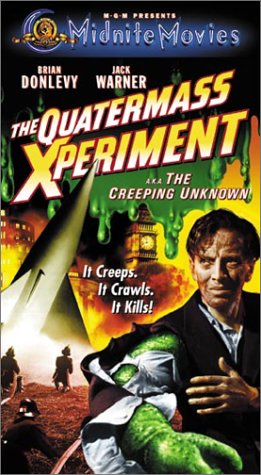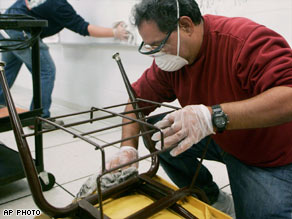Entries in Popular Culture (53)
AIDS vaccine failure sends researchers back to Square One
 MSNBC has an excellent article today about the failure of Merck's AIDS vaccine and what it means to public health and medical research. Robert Bazell, NBC News's chief science and medicine correspondent, writes the following:
MSNBC has an excellent article today about the failure of Merck's AIDS vaccine and what it means to public health and medical research. Robert Bazell, NBC News's chief science and medicine correspondent, writes the following:
Indeed the vaccine development world is now in a state of stunned shock since the trial that many believed had the greatest chance of success was halted. At this point, it looks like an AIDS vaccine remains decades away, if one is ever to be found
Merck’s experimental vaccine did not simply fail to protect people. There were more infections among men who got the vaccine — 49 out of 914 — than those receiving a placebo — 33 of 922. There is no way the vaccine itself could have infected people. But the results raise the frightening prospect that the vaccine actually increased people’s chance of getting infected through sex or injection drugs. (bold mine)
“I don’t want to be Pollyanna and I don’t want to be Chicken Little. But we could have a very serious problem,” said Dr. Anthony Fauci, director of the National Institute of Allergy and Infectious Diseases.
I found the following paragraphs to be interesting, if just coincidental, for the discussion of an old virus come back to haunt us -- adenovirus.
But what happened among the mostly gay male volunteers? Merck’s vaccine combined three proteins produced by the AIDS virus with a modified form of a virus that causes the common cold (adenovirus 5). (bold mine)
Preliminary analysis of the data finds that those who became infected with HIV mounted the strongest immune reaction to the adenovirus. This could be a fluke with this adenovirus. But it also could be something far more significant.
Bazell concludes his remarks with this paragraph:
But meanwhile we do know that treatment works well for those who are infected, and old-fashioned prevention efforts keep people from getting infected in the first place. Perhaps it is time to re-think the priorities. (bold mine)
HIV/AIDS is preventable. With the exclusion of those unfortunates who get infected unknowingly from spouses and partners who are unfaithful, or from tainted blood or organs, the application of simple common sense is a powerful agent against this pandemic disease.
Spores from Space?
 Jim Oberg has written a dandy little piece of cosmic speculation. Jim, or James Oberg as you may know him, is one of America's best space writers, and is also an expert at Russian space history. His seminal work Red Star in Orbit is one of my all-time favorite books, and has nifty pictures such as cosmonaut group photos -- and the same photos with certain cosmonauts airbrushed out, which helped the CIA determine which Soviets went up but never came back.
Jim Oberg has written a dandy little piece of cosmic speculation. Jim, or James Oberg as you may know him, is one of America's best space writers, and is also an expert at Russian space history. His seminal work Red Star in Orbit is one of my all-time favorite books, and has nifty pictures such as cosmonaut group photos -- and the same photos with certain cosmonauts airbrushed out, which helped the CIA determine which Soviets went up but never came back.
Anyway, Oberg recognizes that this is the 50th anniversary of not only Sputnik, but "Muttnik," when spacedog Laika was blasted into orbit. The article, titled "How a dog blazed the trail for life in space -- Russia’s Laika and microbial hitchhikers were launched 50 years ago" can be read in its entirety at: http://www.msnbc.msn.com/id/21596557/
Oberg writes specifically about the microbes that Laika carried with her into space -- and postulates that some of those microbes are still floating in space, or may have settled on the moon. Read on:
 Even during that first flight, Laika did not ride alone. Like all advanced organisms on Earth, the dog carried an array of microorganisms in every nook and cranny of her body. Laika herself died of overheating just a few hours after launch, due to a thermal control system failure — a fact concealed by the Russians for decades. But that was hardly the end of the voyage.
Even during that first flight, Laika did not ride alone. Like all advanced organisms on Earth, the dog carried an array of microorganisms in every nook and cranny of her body. Laika herself died of overheating just a few hours after launch, due to a thermal control system failure — a fact concealed by the Russians for decades. But that was hardly the end of the voyage.
The other living organisms in Sputnik 2 would have continued to thrive for the nearly six months the satellite remained in orbit, living off the biological materials and water provided by Laika’s body. Temperatures inside the inert vehicle were well within the range in which Earth life can function, and the pressurized cabin would have remained intact.
Everything was destroyed — and likely sterilized — when the satellite slipped into the upper atmosphere on April 14, 1958. The forms that the "Laika biosphere" took can only be speculated about. But some microbes almost certainly survived until the very end.
Humans may be contaminating the solar system by the most innocent of methods. Here's a report about a technician with a cold, who might have further contaminated the moon:
A decade later, an even bolder small step for earth germs may have occurred when a worker at a spacecraft workshop in California sneezed on a television camera he was assembling. Installed in the Surveyor 3 robot moon lander, the device landed on the moon in April 1967. Apollo 12 astronauts retrieved samples of the lander in November 1969, and when several spots inside the camera were tested in a laboratory for microorganisms, one sample turned out to provide viable human-borne germs.
That idea has a broader but still widely unrecognized implication: Such conditions — exposure to terrestrial contamination during manufacture, followed by protection in a survivable environment after launch — also could apply to dozens of other space vehicles that have been launched to the moon, Mars and Venus. This is particularly true for Russian space probes, where deliberately pressurized canisters hold the electronics.
 The thought of our own germs coming back to haunt us in strange and alien-mutated ways has always been a staple of science fiction. My personal favorite in the genre is The Quatermass Experiment (aka The Creeping Unknown with Brian Donlevy, one of my favorite movies of all time). However, in the vacuum of space, with no gravity and with an interesting playpen of humans living in a canister together, the possibilities for a mutant bacteria or virus are legion. Oberg continues:
The thought of our own germs coming back to haunt us in strange and alien-mutated ways has always been a staple of science fiction. My personal favorite in the genre is The Quatermass Experiment (aka The Creeping Unknown with Brian Donlevy, one of my favorite movies of all time). However, in the vacuum of space, with no gravity and with an interesting playpen of humans living in a canister together, the possibilities for a mutant bacteria or virus are legion. Oberg continues:
It’s impossible to know how long microbes or spores could survive in dormant state. Certainly, barring an accidental splash or two of borscht, they would have had no nourishment for growth. Maybe someday it will be possible to retrieve one of those early interplanetary probes and take a look — if the descendants of its original inhabitants permit it!
Closer to Earth but still in space, the lustiness of microbial growth is strikingly illustrated by experience on long-term space stations, such as Skylab (where bacteria probably thrived for years on garbage and human waste in the craft's trash module) and on the Russian Mir station, where fungi colonies actually grew on portholes (feeding on human skin peelings) and were so thick they obscured the view. (bold mine)
The fungi on Mir also excreted highly corrosive waste products that actually etched into the porthole glass and its titanium frame. Russian scientists found that the fungi and other microorganisms mutated wildly in the higher radiation levels of space. (ditto)
Researchers already have found that when salmonella bacteria were carried into orbit, they morphed into a new strain that was even deadlier when it was brought back to Earth. In the far future, the most dangerous space aliens might turn out not to be aliens at all — but rather the creatures we've been bringing with us to the final frontier, starting 50 years ago with one dog and several million microbial hitchhikers. (bold again mine)
The quarantine the Apollo 11 astronauts endured (and their fellow sojourners) was a dang good idea. No telling what alien life forms might have hitchhiked along with them! This does, I think, bring up an excellent point about the possibility that future microbial life on distant planets and planetoids might be terrestrial in origin, after all.
The abuse of the word "pandemic" pandemic
Can we please stop the overuse and misuse of the word "Pandemic?"
Like many of you, I subscribe to Google Alerts to get information on influenza and other diseases. One of my keywords is "pandemic." And while it assures me of the latest links to articles and blogs regarding pandemic preparedness, it also sends me some pretty needless stuff -- plus it gets my blood boiling sometimes.
First, we can understand when Pandemic Studios comes up, and there's not much we can do about that. Pandemic Studios is a video game company (or interactive entertainment company, as their trade association likes to say). Pandemic is in the news quite a lot, because they a) are very good at what they do, and b) just got bought out by Bono's video game investment capital firm.
But it's the other references that drive me crazy. We have the "obesity pandemic;" the "drug addiction" pandemic; the "insomnia pandemic"; the "stress pandemic;' we even have a "sexual violence pandemic," according to the UN Secretary General.
My gosh, what we really have here is a pandemic pandemic. The overuse of the word, the misuse of the word, has itself reached pandemic status. My favorite definition of the word comes from the Website MedicineNet.com, and the link is: http://www.medterms.com/script/main/art.asp?articlekey=4751 .
Pandemic: An epidemic (a sudden outbreak) that becomes very widespread and affects a whole region, a continent, or the world.
By contrast:
- An epidemic affects more than the expected number of cases of disease occurring in a community or region during a given period of time. A sudden severe outbreak within a region or a group as, for example, AIDS in Africa or AIDS in intravenous drug users.
- An endemic is present in a community at all times but in low frequency. An endemic is continuous as in the case of malaria in some areas of the world or as with illicit drugs in some neighborhoods.
The word "pandemic" comes from the Greek "pan-", "all" + "demos", "people or population" = "pandemos" = "all the people." A pandemic affects all (nearly all) of the people. By contrast, "epi-" means "upon." An epidemic is visited upon the people. And "en-" means "in." An endemic is in the people.
Of course, in the influenza world, the definition is refined. From the WHO:
An influenza pandemic occurs when a new influenza virus appears against which the human population has no immunity, resulting in several, simultaneous epidemics worldwide with enormous numbers of deaths and illness. With the increase in global transport and communications, as well as urbanization and overcrowded conditions, epidemics due the new influenza virus are likely to quickly take hold around the world.
There is only one pandemic in the world today: HIV/AIDS. That's it. There are epidemics of all kinds of diseases, but only one true pandemic -- at least right now. So let's curtail the use of the word "pandemic" so it carries the necessary and appropriate weight when a real pandemic does happen. Please spread the word and flog the next reporter -- or blogger -- who misuses the word.
The MRSA march continues -- on keyboards and in class
 The stream of MRSA-related newspaper articles has now developed into a flood of print and online activity. here is a digest of a few of today's stories:
The stream of MRSA-related newspaper articles has now developed into a flood of print and online activity. here is a digest of a few of today's stories:
Palmetto High School in a very affluent suburb of Miami, Florida, has been hit with a MRSA infection. Specifically, five members of the football team have been diagnosed as MRSA-positive. In adjacent Broward County, the district is awash in MRSA-suspected cases -- and also awash in parent complaints about the safety of several local schools. The story is at the Miami Herald Website: http://www.miamiherald.com/tropical_life/story/288484.html .
The New York Times reports on the death of Brooklyn seventh-grader Omar Rivera (photo), who died of MRSA this week. The Times article also mentions that in neighboring New Jersey, state officials sent a memo to the superintendents of the state’s 615 school districts asking them to report any individual MRSA cases to the Education Department. Since then, districts have reported about two dozen cases among students and staff in recent weeks, officials said. Quoting from the Times story:
In recent weeks, reported MRSA cases have cropped up in schools around the New York metropolitan region. Students at two separate schools in Longwood, in Suffolk County, were discovered to have the infection by members of the nursing staff, who were told a month ago to watch out for the symptoms, said Michael R. Lonergan, the deputy superintendent.
In Southampton, school officials sent out general information about MRSA to parents last week and disinfected locker rooms and wrestling mats as a precaution before learning that three high-school students, all athletes, had become infected, according to the schools superintendent, J. Richard Boyes.
The story is at http://www.nytimes.com/2007/10/26/nyregion/26infect.html?pagewanted=2&_r=1&ref=todayspaper
 The photo at left is of a MRSA cleanup in a Chicago school. The task is being repeated in classrooms, gyms and cafeterias across the nation.
The photo at left is of a MRSA cleanup in a Chicago school. The task is being repeated in classrooms, gyms and cafeterias across the nation.
Alert blog reader Richard Schmitt of the Florida Department of Education sent me this AP/CNN story, regarding a MRSA scrubdown of an entire school district in Kentucky.
PIKEVILLE, Kentucky (AP) -- An eastern Kentucky school district with one confirmed case of antibiotic-resistant staph infection plans to shut down all 23 of its schools Monday, affecting about 10,300 students, to disinfect the facilities.The project will involve disinfecting classrooms, restrooms, cafeterias, hallways, locker rooms, buses and even external areas such as playgrounds and sports fields, said Roger Wagner, superintendent of Pike County schools.
"We're not closing schools because there's been a large number of breakouts, but as a preventive measure," Wagner said.
Two weeks ago, students staged a sit-in at the lunch room of Pike Central High School in effort to get school officials to clean the school as protection against the bacteria.
Most abandoned the sit-in after Principal David Rowe threatened them with a three-day suspension, but 33 stayed and were given the choice of one day of in-school suspension or two days out-of-school suspension.
Three chose out-of-school suspension.
A wise choice for the students. The story is at http://www.cnn.com/2007/US/10/27/mrsa.school.cleaning.ap/index.html .
So the truth is out there, Mulder, and the truth is we have a massive, underground, unreported epidemic of MRSA rolling across the nation. Everything from wicked-looking scrapes to misdiagnosed brown recluse spider bites are probably, in fact, MRSA infections (see my earlier blog, http://www.scottmcpherson.net/journal/2007/10/24/excellent-apmsnbc-story-on-lax-hospital-protocols.html, for details).
Some think the story is overblown, and many in the media and the Blogosphere equivalent of the Flat Earth Society are dismissing the MRSA flood of stories as the New Bird Flu. Of course, if you are reading this, then you know what side of THAT debate you sit on. But it is preposterous to poo-poo MRSA as much ado about nothing when we do not even know the tip of the iceberg regarding potential vectors of infection.
Speaking of vectors of MRSA infection, how about this one? A link to a research paper was sent to me by alert blogger Robyn Klein, AHG herbalist, MSc. Medical Botany, and an adjunct instructor with the Department of Plant Sciences and Plant Pathology at Montana State University. Her blogsite is http://www.rrreading.com/index.html.
The paper is titled "Public computer surfaces are reservoirs for methicillin-resistant staphylococci", and the authors are Issmat I Kassem, Von Sigler and Malak A Esseili of the Laboratory for Microbial Ecology, Department of Environmental Sciences, University of Toledo, Toledo, Ohio. I was able to procure the paper privately.
The following is just from the foreword!
The role of computer keyboards used by students of a metropolitan university as reservoirs of antibiotic-resistant staphylococci was determined. Putative methicillin (oxacillin)-resistant staphylococci isolates were identified from keyboard swabs following a combination of biochemical and genetic analyses. Of 24 keyboards surveyed, 17 were contaminated with staphylococci that grew in the presence of oxacillin (2mgl1). Methicillin (oxacillin)-resistant Staphylococcus aureus (MRSA), -S. epidermidis (MRSE) and -S. hominis (MRSH) were present on two, five and two keyboards, respectively, while all three staphylococci co-contaminated one keyboard. Furthermore, these were found to be part of a greater community of oxacillin-resistant bacteria. Combined with the broad user base common to public computers, the presence of antibiotic-resistant staphylococci on keyboard surfaces might impact the transmission and prevalence of pathogens throughout the community.
The article is available for purchase at: http://www.nature.com/ismej/journal/v1/n3/abs/ismej200736a.html.
All-righty then! Public keyboards -- in universities, in libraries, in classrooms, at kiosks, at ATM machines, I'll let you fill in your imagination here -- are now proven vectors of MRSA. This means that the equipment kids use in school has to be decontaminated frequently, and probably daily.
I will say what everyone is, or should be, thinking. We are ushering in the Golden Age of Disease. Killer bugs, resistant to the best antibiotics, are growing in our schools, prisons, jails, colleges, hospitals, and probably churches too if we bothered to check. Influenzas with the capacity to kill hundreds of millions are brewing in the bellies of wild birds, in the throats of unknowing chickens and ducks, and in God knows how many pigs, cats and dogs across Asia. Mosquitoes are spreading across the developing world with almost unthinkable misery-causing and deadly pathogens.
And it is all heading our way. MRSA just beat the rest to Home Base. Home base is every playground, school, gymnasium, hospital and public meeting place in America.
Makes you want to start using your gloves now, doesn't it? How we manage such issues as seasonal flu, MRSA, and other diseases gives us clues as to how we will manage the Next Pandemic.
Early returns show we won't fare well at all.
An interview with Elliott Masie
 Yesterday, I had the grand opportunity to be interviewed by "learning guru" Elliott Masie on the topic of pandemic influenza preparedness and the role that the chief learning officers and chief training officers of business, industry, academia and government will be asked/forced to play in preparing for, and mitigating the effects of, pandemic influenza. Heckuva sentence, huh?
Yesterday, I had the grand opportunity to be interviewed by "learning guru" Elliott Masie on the topic of pandemic influenza preparedness and the role that the chief learning officers and chief training officers of business, industry, academia and government will be asked/forced to play in preparing for, and mitigating the effects of, pandemic influenza. Heckuva sentence, huh?
I am unfamiliar with the "training and learning universe," so I did exactly what Elliott did to come up with my name: I Googled him. He is an extremely well-respected and admired advocate of innovation and reinventing the entire learning and training experience. He is also a facilitator and incubator of ideas. His organization, the MASIE Center (www.masieweb.com) is a major supporter of the Malaria No More project, at http://www.malarianomore.org/. His conference, currently under way in Orlando, has more than 2,100 attendees from 29 countries.
Masie also "vetted" me through the Central Intelligence Agency beforehand, which has caused me to start speaking in a friendly tone of voice to the little fire sprinkler I have in the ceiling of my office. Anyway, with that kind of gravitas, I could not possibly resist his request for me to come down and have a personal discussion on influenza in front of twenty-one hundred of his closest friends!
We covered 1918, H5N1 and world history. We covered my favorite line, WWID, or What Would Ike Do, regarding panflu planning. But I asked a question of the audience. I said, How many of you are currently involved in pandemic preparedness within your organization?
A fair number of hands shot up. But then Elliott turned the question inside out and asked, How many of them were not involved?
A sea of arms and hands shot up. Our look of surprise had to be evident on the two hi-def screens on either side of the stage. We were both amazed that such a key pandemic resource as learning and training was being overlooked by upper management. That, I feel, is symptomatic of where we are as a nation today with pandemic preparedness. Few corporate leaders are seriously engaged in out-of-the-box thinking on this topic. For every Michael Dell, who I can personally assure you is engaged on this topic, there are ten thousand flu-clueless captains of industry. For every Michael Leavitt, there are ten thousand flu-clueless agency heads, elected officials and political leaders nationwide.
CTOs and CLOs are a growing and influential lot. And they were told, by Elliott and by me, that they need to become pandemic subject matter experts and agents for change within their own organizations. Trainers and learning professionals need to quickly ramp up their knowledge of influenza, and of H5N1 in particular, I told the assembly. Read John Barry's The Great Influenza. Learn how to overcome supply chain failures. Subscribe to Google alerts. Go to flu blog sites and other important flu sites. Learn as much as they can about the disease themselves. Don't rely upon the American mainstream media for when to prepare. Be prepared to teach employees how to prepare -- and care for -- their families. And know when the whole thing is about to go Pop!
So you captains of industry and government, pull up an empty chair for the learning and training officers. They are your best hope at imparting the necessary knowledge and skills necesary to weather this coming storm.
